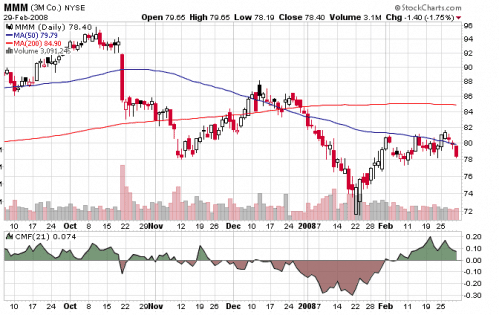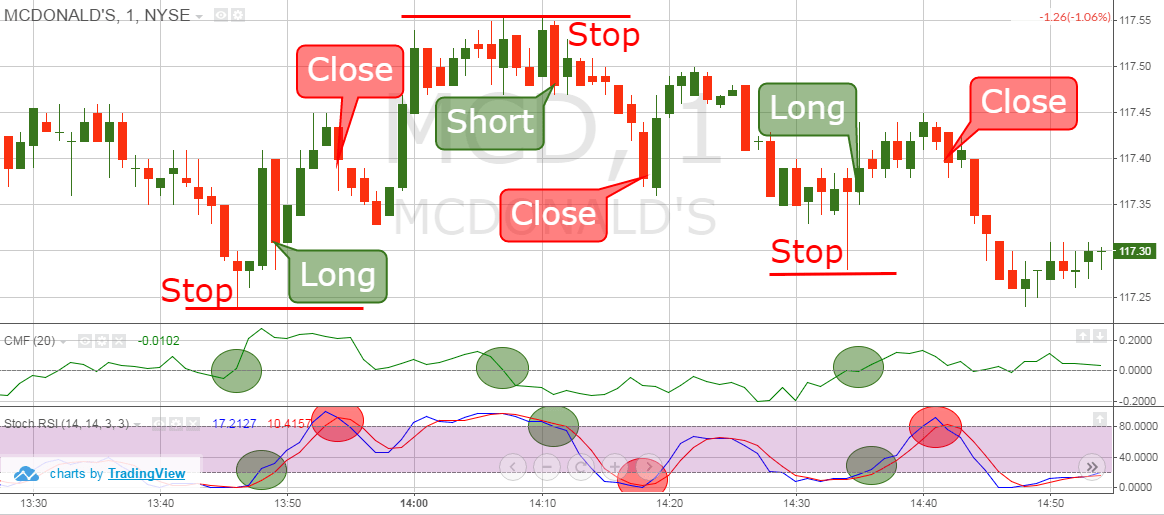Chaikin Money Flow Indicator Review

Illustrated above is a zoomed in screenshot of the Chaikin Money Flow (CMF) index from the Tradingsim platform. As you can see, the indicator is a simple curved line, which fluctuates below and above a zero level. The CMF is configurable, thereby allowing traders to customize the settings to meet their trading needs. You will also notice that the indicator produces standard chart formations (i.e. double tops, trend lines, etc.) which can also provide trade triggers.
In this article we will provide a thorough overview of the indicator and provide 2 simple trading strategies you can use test drive using the Chaikin Money Flow index.
Chaikin Money Flow Definition
The chaikin money flow was developed by Marc Chaikin and attempts to determine if a stock is under accumulation or distribution by comparing the closing price to the high-low range of the trading session. In layman’s terms, if the stock closes near the high of the session with increased volume, the CMF increases in value. Conversely, if the stock closes near the low of the session with increased volume, the CMF decreases in value. The chaikin money flow indicator was developed as an expansion to the On Balance Volume indicator.
Chaikin Money Flow Formula
The chaikin money flow indicator is calculated by summing the accumulation/distribution line for “x” periods. Traders generally use 21-periods for calculating the indicator. Below is the formula for the CMF indicator:

Trading with the Chaikin Money Flow Indicator
Zero Line Crosses
The basic trading premise with the CMF indicator is if the indicator is above 0 this is a bullish sign, while a reading below 0 represents a bearish signal. Reading above +.25 or below -.25 indicate strong trends and positions can be added on minor corrections.
Trend Lines
Like many other indicators, traders will draw trend lines on the indicators themselves and look for both breakouts on the indicator and the price on the chart. This method is very subjective, since the trader will have to accurately identify the trend on the indicator.
Divergence
Divergence can show up in the indicator when the chaikin money flow indicator makes a higher high, while the price action makes a lower low. This implies that there is less selling pressure pushing the security lower, thus a bounce is in order.
Chaikin Money Flow Charting Example

Above you see the daily chart of 3M for Oct, 2007 – Feb, 2008. On the chart, we also have 50-period and a 200-period Simple Moving Averages.
Notice that in the beginning of December, 2007, the Chaikin line begins crossing below the horizontal zero level. At the same time, we see that the blue 50-period SMA switches below the red 200-period SMA.
Then at the end of December, 2008, the Chaikin Index starts providing relatively lower readings. This gives us a signal that the MMM price might start decreasing with higher intensity, which is exactly what happens next.
For 22 days, 3M’s price decreases 12.20%. 5 days later, the Chaikin Money Flow index confirms a double bottom chart pattern, which was the perfect opportunity to exit the trade.
Now that we have covered a swing trade example, let’s dig into a few day trading strategies using the CMF.
Chaikin Money Flow Trading
As you probably know, the most common disadvantage of oscillators is that they are not great standalone indicators. Therefore, let’s explore additional trading indicators you can use to validate signals provided by the Chaikin Money Flow Index.
2-Minute Chart Chaikin Money Flow + 15-Period EMA Trading
This strategy can be used by short-term traders to identify higher probability entry and exit points. First, we are using a 2-minute chart in order to identify setups on a lower time frame. Secondly, we only want to enter trades based on extreme Chaikin Oscillator readings, +0.2000 or -0.2000.
At the same time, we will use the 15-period exponential moving average to confirm the trade signal. We will then stay in the trade until the price closes above or below the 15-period EMA.

Above you see the 2-minute chart of Visa from Sep 15, 2015. At the bottom of the chart, you see the Chaikin Money Flow index. The blue curved line on the chart is our 15-period Exponential Moving Average.
In this example, there were two trade signals generated with this strategy – one bullish and one bearish.
In the first green circle, you see the moment when the price switches above the 15-period EMA. This is the long signal we need from our EMA. 15 minutes later, the Chaikin line increases above +0.2000, which is considered a very high reading. We get a long signal confirmation and we buy Visa at $70.08 per share. This trade lasts for almost an hour, which is pretty long for a day trade. This trade generated $0.35 cents of profit (.5%).
The next trade signal materializes after the price switches below the EMA and we receive an extreme reading of -0.2000 on the Chaikin.
For this reason, we short Visa at $70.45 per share. The black arrows on the chart show the moments where the price tests the 15-period EMA as resistance. The price action for this move wasn’t as impulsive; however, in this example a trader could have made $.10 (10 cents) per share, or .14% of profit.
Scalping with the Chaikin Index and Stochastic RSI on a 1-Minute Chart
In this strategy, the point is to hit stocks for minimum profits and then exit the trade. In most cases, trades will last no more than 10 minutes.
In order to enter a position based on this strategy, we will need a double signal combination from each of these indicators. At the same time, we will stay in each trade until we receive a trade signal from the Stochastic RSI.
In other words, it will take more effort to enter a trade versus closing one. This creates the scalping effect.
Let’s now approach an example of this trading strategy.

Above you see the 1-minute chart of MC Donald’s from Feb 11, 2016. The image illustrates three scalp trades based on signals from the Chaikin and the Stochastic.
We start with the first trade. The Stochastic RSI is in the oversold area. Suddenly, the Chaikin crosses the zero level, giving us a long signal. A couple of periods later, the Stochastic exits the oversold area, which gives us a buy signal; therefore a long signal is generated at 117.31 per share.
Five minutes later the stochastic enters the overbought area and its lines cross downwards. We receive an exit signal and we close our trade at 117.40 per share. This trade generated $0.09 (9 cents) per share, which is a 0.08% increase for 5 minutes.
The second trade comes when the Chaikin breaks the zero level downwards. The Stochastic RSI is already in the overbought territory. Three periods after the Chaikin signal, the Stochastic exits the overbought area, giving us a sell signal.
We short MCD at 117.48 per share. Four periods later the Stochastic enters the oversold area. 15 minutes after entering the oversold area, the stochastic begins to cross upwards, giving us our exit signal at 117.38 per share. This trade generated $0.10 (10 cents) per share, which equals to 0.09% profit in 7 minutes.
The third trade comes the next time the Chaikin line switches sides. The Chaikin indicator breaks its Zero level in a bullish direction, while the Stochastic RSI is already in the oversold area. In the next period, we see the stochastic lines breaking out of the oversold area. This gives us a buy signal and we go long with the MCD stock at 117.36 per share. The price begins a slight increase afterwards. The Stochastic RSI is increasing too, entering the overbought area. Seven minutes later the stochastic lines cross downwards exiting the overbought area. This creates an exit signal and we close our long trade with MC Donald’s at 117.39 per share. In this trade we manage to catch only a $0.03 (3 cents) price increase, which equals to 0.03% for 7 minutes.
The total outcome from this Chaikin Money Flow trading system is 0.2% from three trades. We spend only 19 minutes in total for all of these trades.
Although this doesn’t look very attractive, imagine you execute not 3 but 30 scalp trades per day with this strategy. This way you will have the opportunity to reach 10 times higher profit. This turns the minor 0.2% into a more healthy 2.00%.
The key for successfully pulling off this strategy is to keep your trading commissions low. If you have a .1% commission per trade, then this will not be a profitable proposition for you.
Also, you have to effectively manage your money. For example, if you decide to plunge on one of the trades and it goes against you, then you could be facing some serious financial problems.
Stop Loss with Chaikin Index
Now that we have covered two simple strategies, we of course need to touch upon the topic of how to stop out of trades. Please remember, that without a stop loss strategy, danger is looming around the corner.
We start with the 2-Minute Chaikin Money Flow + 15-Period EMA strategy. Since you are entering trades based on a relatively high or low Chaikin value, assisted by an EMA breakout, then your stop should be somewhere below your EMA. The image below will show you where your stops should be located when trading the 2-minute chart with Chaikin Money Flow and a 15-period EMA.

Let’s now approach the scalp trading strategy which includes the Chaikin Money Flow and the Stochastic RSI. This is a high frequency strategy. For this reason, there is a greater chance for huge unexpected moves against your trades. Furthermore, we scalp for tiny profits of less than 0.1%. Imagine a 1.00% loss on a trade with 0.1% profit potential. This is how ugly it could turn if you don’t use a stop loss when scalping.
Since you are hitting for small profits, the stop loss positioning is relatively easy to implement. Simply find the bottom, which is associated with the beginning of the price move you are attempting to trade. If you cannot associate such bottoms with the current price action, simply use the previous bottom. Have a look at the image below.

This time we have included the location of the stop loss levels. Notice that we use not only the candle bodies to position the stop, but we also conform to the wicks. In this manner, the third trade had a negative risk-to-return ratio. Therefore, you will want to avoid these sort of setups, because if one or two of these go against you a day, you can start to blow up your account.
Conclusion
- The Chaikin Money Flow (CMF) determines if a stock is under accumulation or distribution.
- The Chaikin formula takes into consideration the close, the low, the high, and the volumes during a certain period on the chart.
- We covered three types of trade signals in this article:
– Zero Line Crosses
– Trend Breakouts
– Divergence
- The Chaikin Money Flow is not a good standalone tool.
- Two strategies covered in this article are:
– Trading a 2-minute chart with the CMF and 15-period EMA
– Scalping a 1-minute chart with the CMF and Stochastic RSI
- Always use a stop loss when you trade with the Chaikin Money Flow.
To test this strategy out and others you maybe kicking around, please visit Tradingsim.com to see how we can help.


what are the parameters
what are the parameters
The look back period for CMF on most applications is 2o periods.
may i know the adv and disadv of chaikin money flow